Inorganic Geochemistry

Sample preparation room
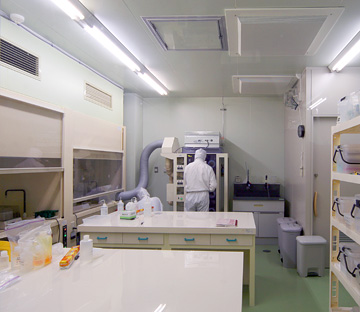
| 概要 |
|---|
| This room is for sample preparations for rare/trace element analyses that is potentially-impacted by dust-particles. This room has very low level of environmental pollutants such as dust, airborne microbes and aerosol particles because the air in the room is rentilated through fine pore size filters (High Efficiency Particulate Air Filter : HEPA). |
Double-Focusing High Resolution ICP Multi-Collector Mass Spectrometer (ICP-MC-MS)
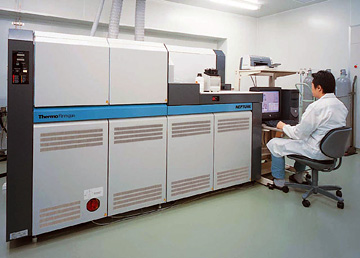
| This mass spectrometer is designed for analyzing isotope ratios of high ionization potential elements precisely owing to the high ionization efficiency of ICP and its relatively constant mass discrimination over time. Simultaneous detection of multiple isotopes separated through a sector magnetic field is capable with an array of nine ion detectors. The forward Nier-Johnson double-focusing geometry allows operations under high resolution modes for e.g. Mg and Fe isotopes as well as low resolution mode operation. | ||
| Model | ||
|---|---|---|
| Neptune | ||
| Manufacture | ||
| Thermo Fisher Scientific. Inc. | ||
| Operating condition | ||
Nine Faraday cups and three ion counters are equipped in an array with a mass dispersion of 17% for simultaneous detection of multiple ions to determine precise isotope ratios of elements.
|
||
| Lab. | ||
| ICP-MS |
Thermal Ionization Mass Spectrometer (TIMS)
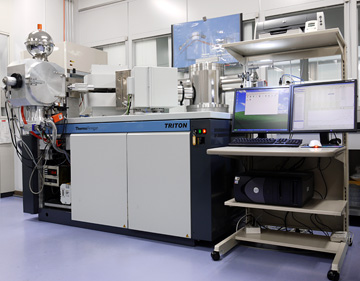
| Thermal ionization mass spectrometer (TIMS) is used for isotope analyses of various geological samples. In TIMS, a salt of the element, chemically separated from the sample, is evaporated onto the metal filament (rhenium, tantalum, tungsten, etc.). The filament is heated at high vacuum, and the emitted ions of the element are separated on the basis of their mass using a magnetic sector mass analyzer. Then the separated ion beam is detected by Faraday cup. | ||
| Model | ||
|---|---|---|
| TRITON TI | ||
| Manufacture | ||
| Thermo Fisher Scientific. Inc. | ||
| Operating condition | ||
|
TRITON equips nine Faraday cups, which allows simultaneous measurement of the intensities of several ions beams. From the intensities of the ions beams, ratios of different masses are calculated to obtain precise isotope ratios of the sample.
|
||
| Lab. | ||
| Inorganic Geochemistry |
Isotope Ratio Mass Spectrometer (IR-MS)
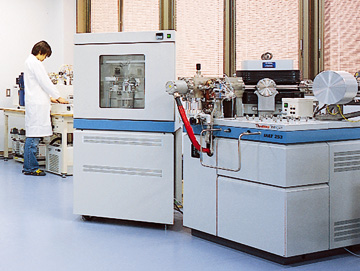
| This Mass Spectrometer is for isotopic analyses of carbonates, the acid dissolution for use with solid or gas samples to study O, N, and C isotopes. |
| Model |
|---|
| Thermo-Finnigan MAT 253 Mass Spectrometer |
| Manufacture |
| Thermo Fisher Scientific. Inc. |
| Operating condition |
| This instrument is equipped with a dual inlet system: a) a external system for purified gas samples collected by "Kiel device III" and b) a gear system for up to 24 small samples with automatic tube crackers. |
| Lab. |
| Inorganic Geochemistry |
IsoPrime
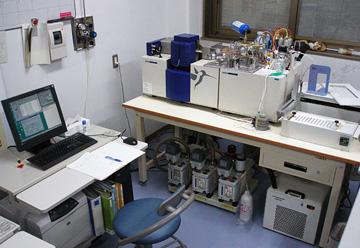
| - | ||||||||||
| Model | ||||||||||
|---|---|---|---|---|---|---|---|---|---|---|
| IsoPrime | ||||||||||
| Manufacture | ||||||||||
| Isoprime Ltd | ||||||||||
| Operating condition | ||||||||||
|
||||||||||
| Lab. | ||||||||||
| Inorganic Geochemistry |
Quadrupole Inductively Coupled Plasma Mass Spectrometer (ICP-MS)
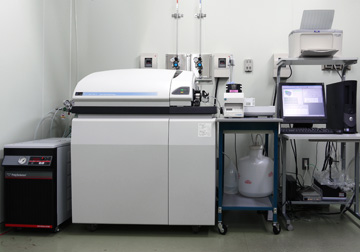
| This mass spectrometer counts ions of elements typically in solution phase. The ions generated at the plasma at 1 atm are extracted into the high-vacuum region through a series of cones, and an objective ion is separated from others through a quadrupole mass filter on the basis of their mass-to-charge ratio. Mass number is characteristic of a particular element, and detection of ions of many elements at a time is possible through a high-speed scanning of a mass range by the quadrupole mass filter. The instrument has no extraction lens to reduce undesirable matrix effects for high matrix element samples at the sacrifice of signal sensitivity. This instrument also equips Dynamic Reaction Cell to neutralize interferences like Ar+ and ArO+ on Ca+ and Fe+ analyses with NH3 reaction gas, and the detection limit is less than 1 ppb for most elements. | ||
| Model | ||
|---|---|---|
| Elan DRCII | ||
| Manufacture | ||
| PerkinElmer, Inc. | ||
| Operating condition | ||
|
||
| Lab. | ||
| ICP-MS |
Inductively coupled plasma atomic emission spectrometer (ICP AES)
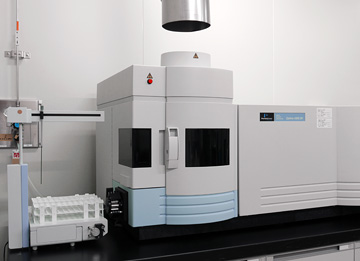
| ICP atomic emission spectrometer is an instrument which detects emitted electromagnetic radiation from excited atoms and ions produced in ICP through diffraction grating. The emission spectrum is characteristic of a particular element, and the intensity is proportional to the concentration of the element in the sample. A combination of Echelle grating and CCD array detector in this instrument allows simultaneous detection of multiple emission lines of elements. Both wide dynamic range and low detection limit are achieved by dual-view of ICP (radial and axial plasma view). Although ICPAES is less sensitive compared to ICPMS, this instrument has advantages in robustness to matrix effects and signal stability because of the "optical" spectrometry without intake sample itself into the instrument. | ||
| Model | ||
|---|---|---|
| Optima DV4300 | ||
| Manufacture | ||
| PerkinElmer, Inc. | ||
| Operating condition | ||
|
||
| Lab. | ||
| ICP-MS |
Atomic Absorption Spectrometer
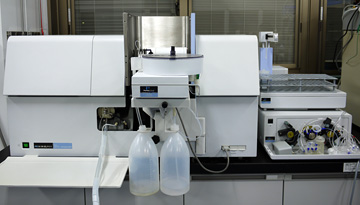
| Atomic absorption spectroscopy is a technique for determining the concentration of a particular metal element in a sample. The technique typically makes use of a flame or graphite furnace to atomize the sample. The electrons of the atoms in the atomizer can be promoted to higher orbitals for an instant by absorbing a set quantity of energy. This amount of energy is specific to a particular electron transition in a particular element. This gives the technique its elemental selectivity. |
| Model |
|---|
| AAnalyst800 |
| Manufacture |
| PerkinElmer Japan |
| Operating condition |
| Direct determination for Alkaline and Alkaline earth elements |
| Lab. |
| Inorganic Geochemistry |

